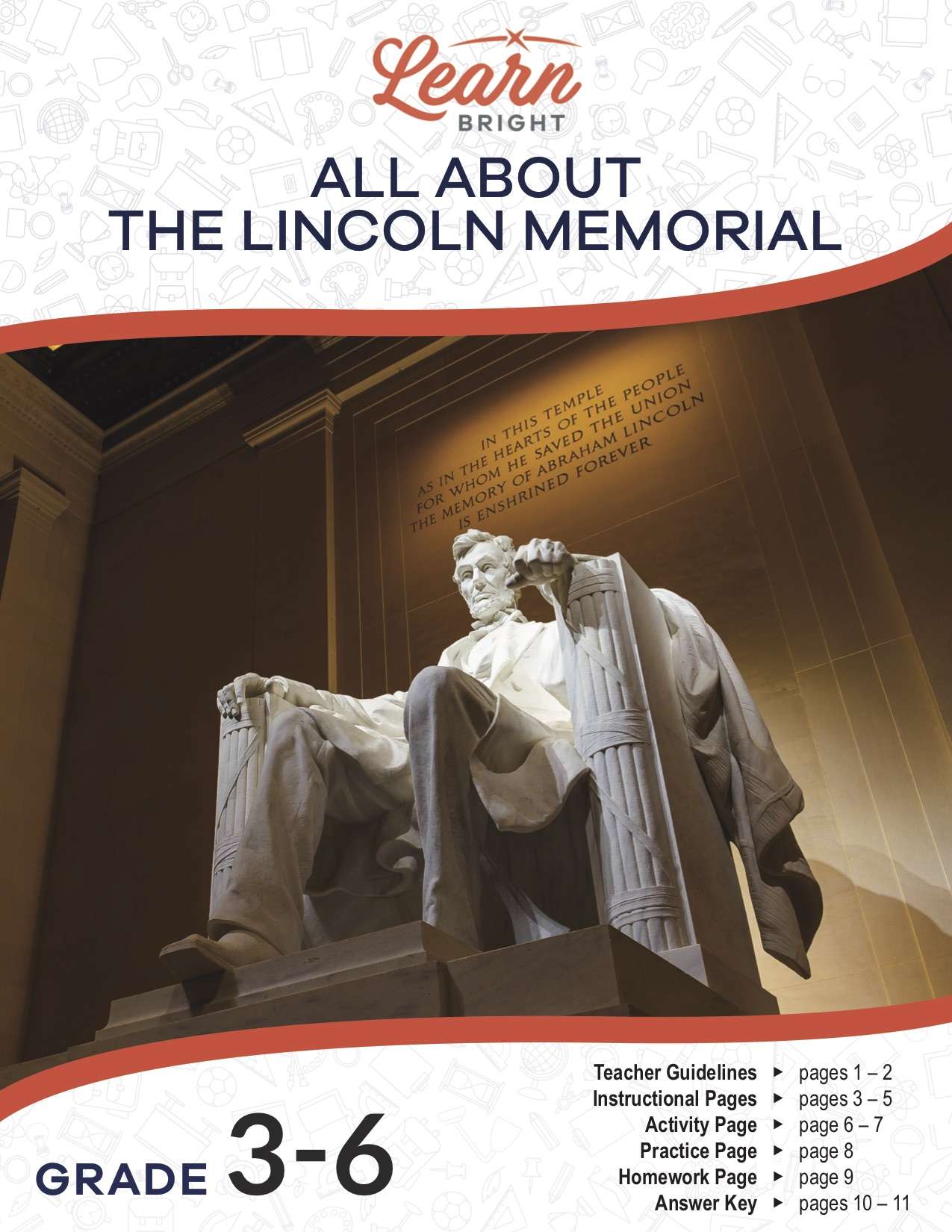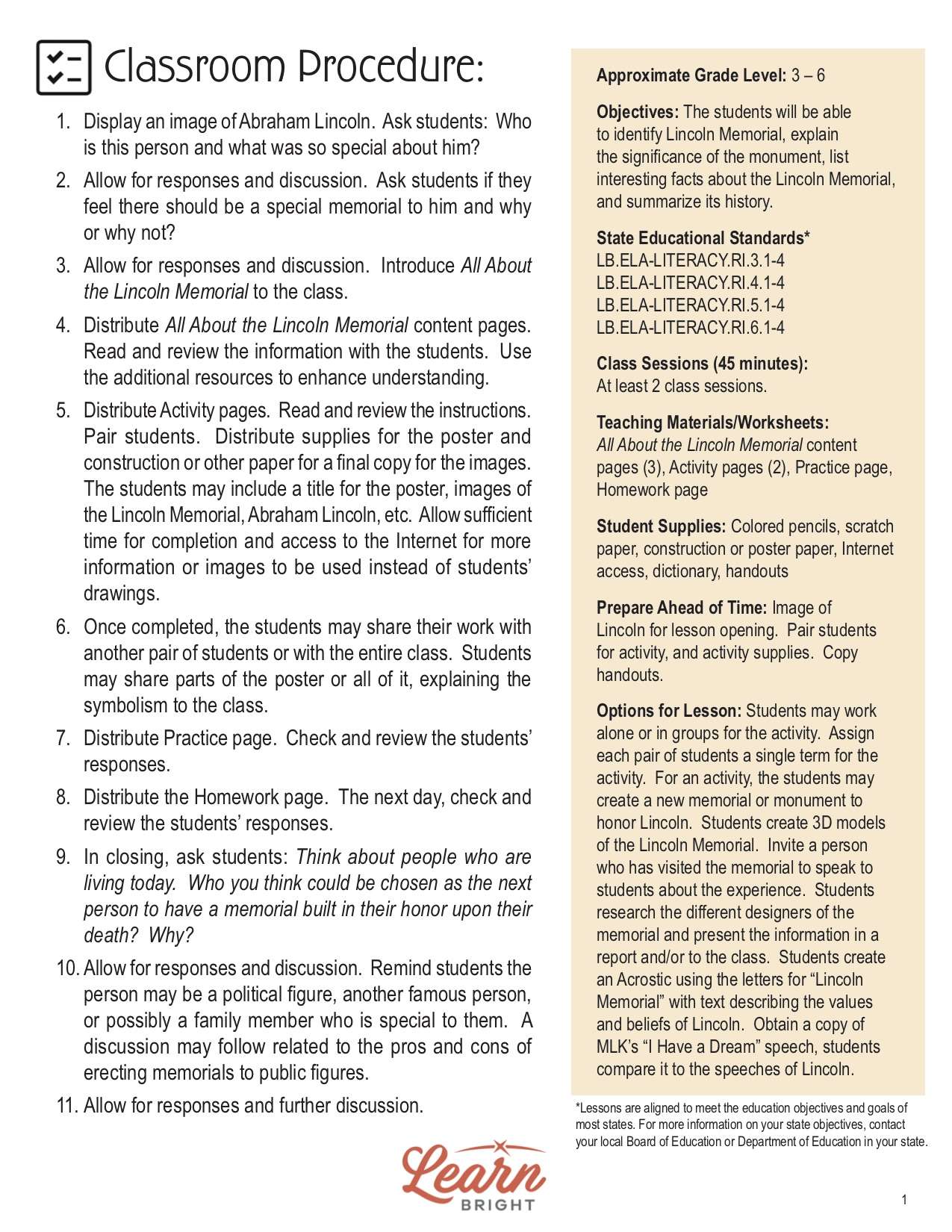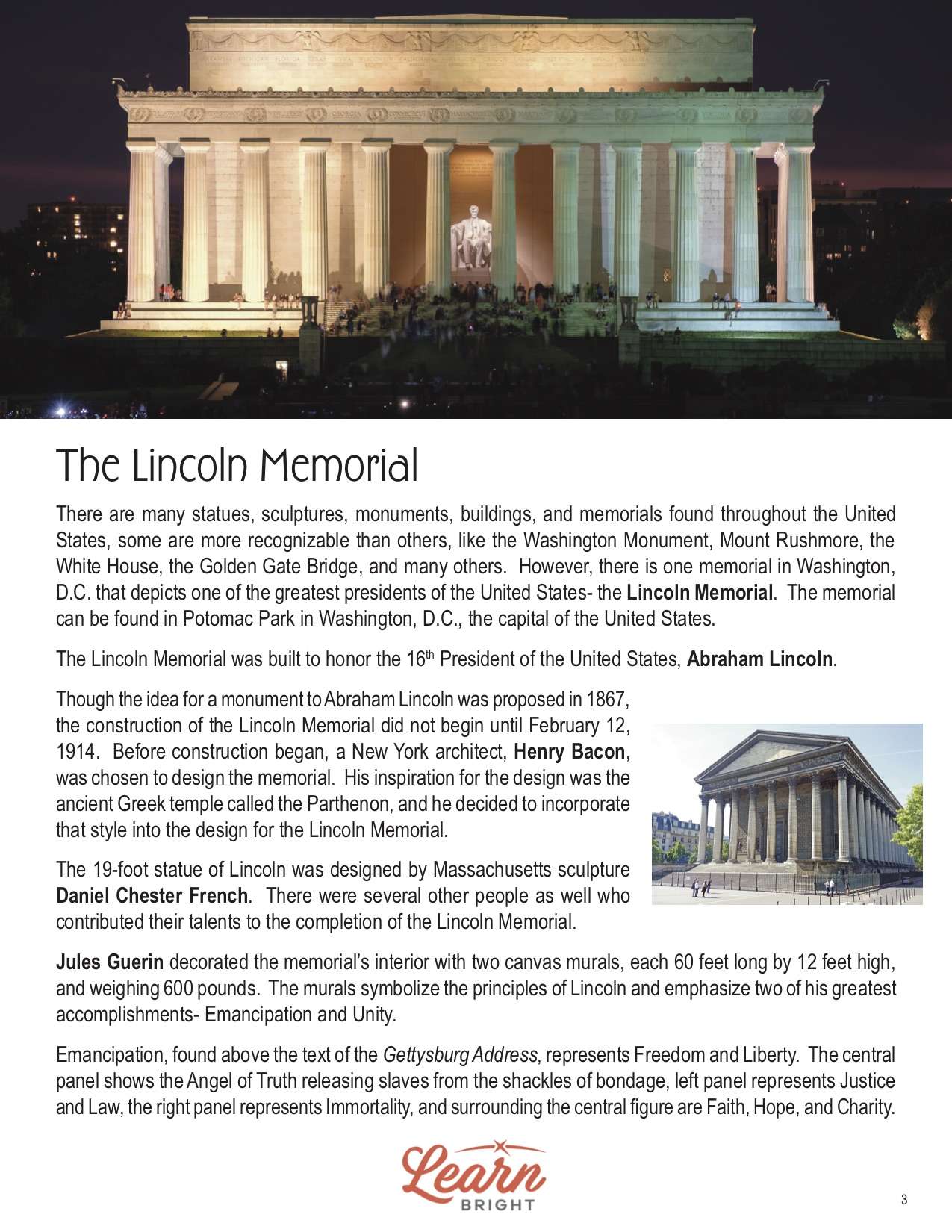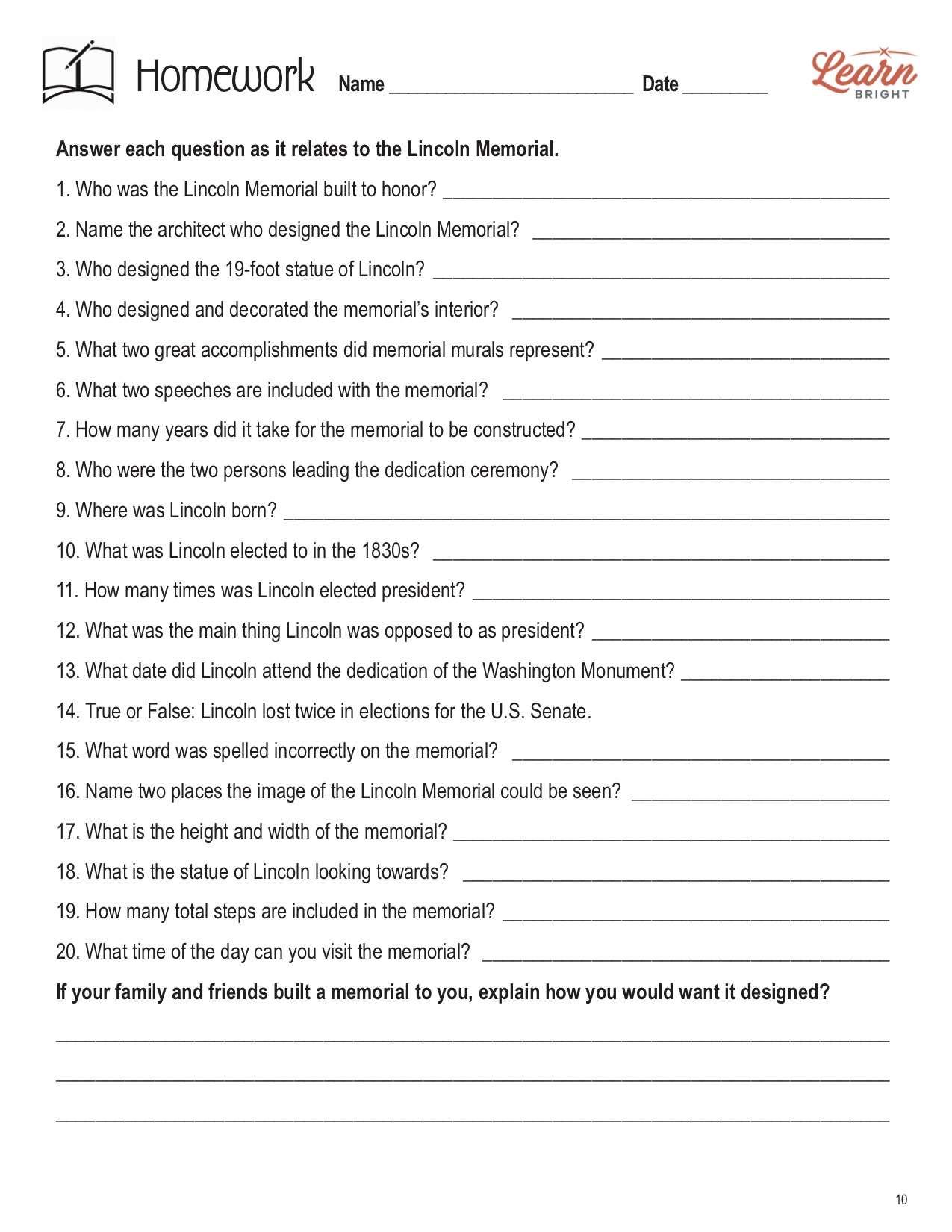Description
What our All about the Lincoln Memorial lesson plan includes
Lesson Objectives and Overview: All about the Lincoln Memorial teaches students about this famous monument and its significance. Students will be able to identify the memorial and list interesting facts. By the end of the lesson, they will be able to summarize its history. This lesson is for students in 3rd grade, 4th grade, 5th grade, and 6th grade.
Classroom Procedure
Every lesson plan provides you with a classroom procedure page that outlines a step-by-step guide to follow. You do not have to follow the guide exactly. The guide helps you organize the lesson and details when to hand out worksheets. It also lists information in the orange box that you might find useful. You will find the lesson objectives, state standards, and number of class sessions the lesson should take to complete in this area. In addition, it describes the supplies you will need as well as what and how you need to prepare beforehand. For this lesson, the supplies you will need include colored pencils, scratch paper, construction or poster paper, internet access, dictionaries, and the handouts. To prepare for this lesson ahead of time, you can gather the supplies, copy the handouts, pair the students for the activity, and find an image of Lincoln for the lesson opening.
Options for Lesson
Included with this lesson is an “Options for Lesson” section that lists a number of suggestions for activities to add to the lesson or substitutions for the ones already in the lesson. One additional activity you can have students do is create a new memorial or monument to celebrate Lincoln. You can also have them create a 3D model of the Lincoln Memorial. Another idea is to have someone who has actually visited the memorial visit your class and speak to your students about that experience. Students can also do research on the various designers of the memorial and present what they’ve learned in a report or as a presentation to the class. Students, especially younger students, can also create an acrostic poem using the letters in “Lincoln Memorial,” including text that describes Lincoln’s values and beliefs. Finally, you can have students compare MLK’s “I Have a Dream” speech with some of Lincoln’s speeches.
Teacher Notes
The teacher notes page includes a paragraph with additional guidelines and things to think about as you begin to plan your lesson. This page also includes lines that you can use to add your own notes as you’re preparing for this lesson.
ALL ABOUT THE LINCOLN MEMORIAL LESSON PLAN CONTENT PAGES
The Lincoln Memorial
The All about the Lincoln Memorial lesson plan has four content pages. There are many statues, sculptures, monuments, buildings, and memorials throughout the United States. Some are more recognizable than others, such as the Washington Monument, Mount Rushmore, and the Golden Gate Bridge. However, there is one memorial that depicts one of the greatest presidents of the United States—the Lincoln Memorial.
The memorial stands in Potomac Park in Washington, DC, the capital of the United States. The Lincoln Memorial was built to honor the 16th president of the United States, Abraham Lincoln. Though the idea for a monument to Abraham Lincoln came to be in 1867, the construction of the structure did not begin until February 12, 1914.
Before construction began, a New York architect, Henry Bacon, was chosen to design the memorial. His inspiration for the design was the ancient Greek temple, the Parthenon. He decided to incorporate that style into the memorial’s design. Massachusetts sculptor Daniel Chester French designed the 19-foot statue of Lincoln. There were several other people as well who contributed their talents to the completion of the Lincoln Memorial.
Murals and Other Details
Jules Guerin decorated the memorial’s interior with two canvas murals. Each mural was 60 feet long by 12 feet high and weighted 600 pounds. The murals symbolize the principles of Lincoln and emphasize two of his greatest accomplishments—emancipation and unity.
Emancipation rests above the text of the Gettysburg Address. It represents freedom and liberty. The central panel shows the Angel of Truth releasing slaves from the shackles of bondage. The left panel represents justice and law, and the right panel represents immortality. Surrounding the central figure are faith, hope, and charity.
Unity, above the Second Inaugural Address, features the Angel of Truth joining the hands of two figures that represent the North and South. The angel’s wings cradle the arts of painting, philosophy, music, architecture, chemistry, literature, and sculpture. Behind the music figure is a veiled image of the future. The left group represents fraternity, and the right, charity. The Unity mural includes the head of the Lincoln Memorial architect, Henry Bacon.
Ernest C. Bairstow was an architectural sculptor who carved many exterior details of the memorial such as the states, wreaths, festoons, and eagles. In addition, Bairstow was responsible for the lettering for the Gettysburg Address, the Second Inaugural Address, and the inscription above the Lincoln statue.
The construction of the memorial lasted from 1914 to 1922. The memorial was dedicated to the people of America on May 30, 1922. Then–former U.S. President William Howard Taft and Robert Lincoln, the only surviving son of Abraham Lincoln, led the ceremony.
Other Interesting Facts
Lincoln is best known for leading the country during the Civil War and abolishing slavery. He was born to a poor family on February 12, 1809, in a Kentucky cabin, and in 1816, his family moved to Indiana. As a young person, his mother taught him to read. He spent many hours studying during his childhood and throughout his informal education.
Lincoln became president in 1861. His first struggle was trying to keep the nation together. On March 4, 1861, he affirmed his charge to “preserve, protect, and defend the Constitution of the United States.” Throughout his first term in office, Lincoln had to lead the country during the Civil War. His leadership and opposition to slavery led to Lincoln’s re-election in 1864 and, eventually, the end of the Civil War and the abolition of slavery. Unfortunately, he was assassinated on May 9, 1865, dying less than a month before the official end of the war.
However, people will always remember Abraham Lincoln for his outspoken opposition to slavery, his leadership during the Civil War, and one of the greatest speeches in history, the Gettysburg Address. The idea for the Lincoln Memorial came to be just two years after Lincoln’s death in 1867. The U.S. Congress created the Lincoln Monument Association with the goal of building a memorial to the president.
In addition, we find the following words inscribed on the wall behind the sculpture: IN THIS TEMPLE AS IN THE HEARTS OF THE PEOPLE FOR WHOM HE SAVED THE UNION THE MEMORY OF ABRAHAM LINCOLN IS ENSHRINED FOREVER. The sentence tells visitors that the Lincoln Memorial was built to help the people of the United States remember Abraham Lincoln forever. It is a reminder of the country or Union he saved as president of the United States.
Lincoln Memorial Facts
- The memorial is surrounded by 38 columns, representing 36 states of the Union at the time of Lincoln’s death. Each one is 37 feet high, with a large reflecting pool right outside the steps.
- The two additional columns, which are 44 feet tall, stand at the entrance.
- A sculpture of Lincoln sitting on a chair is inside the Memorial and shows him looking toward the reflecting pool and the Washington Monument. It weighs about 175 tons.
- The statue is 19 feet 9 inches tall and 19 feet wide. Masons carved it from 28 blocks of white marble.
- In all, the memorial is 99 feet tall and 202 feet wide. The foundation extends 66 feet below ground.
- Other designs for the memorial included a traditional Mayan temple and an Egyptian pyramid.
- There are 58 steps from the chamber to the plaza level and 87 steps from the chamber to pool.
- A typo on the memorial spelled the word “Future” as “Euture”, though the mistake was later corrected.
- Many famous speeches have been recited at the memorial, including Martin Luther King’s “I Have a Dream” speech on August 28, 1963.
- From 1959 to 2008, the Lincoln Memorial was on the reverse side of the penny, and the memorial appears on the back of the five-dollar bill.
- It is open 24 hours per day, and about 6 million people visit it every year.
ALL ABOUT THE LINCOLN MEMORIAL LESSON PLAN WORKSHEETS
The All about the Lincoln Memorial lesson plan includes three worksheets: an activity worksheet, a practice worksheet, and a homework assignment. You can refer to the guide on the classroom procedure page to determine when to hand out each worksheet.
IMAGE FINDING ACTIVITY
Students will work with a partner during this activity, though you may choose to have students work alone or in groups instead if you wish. The activity worksheet displays 12 empty boxes with terms from the text on the Lincoln Memorial. Students will review the words and think of images that they could use that represent each term. They will use the blank space to create a rough draft. Finally, they will create a final draft on a poster board. They can use a dictionary or the internet if they need to clarify the terms.
ALL ABOUT THE LINCOLN MEMORIAL PRACTICE WORKSHEET
The practice worksheet has two sections. The first section requires students to review 10 different dates and numbers. Students must determine how these numbers are significant as they relate to either Lincoln or the memorial. The second section requires them to review MLK’s “I Have a Dream” speech and explain why he chose to deliver it at the Lincoln Memorial. There are several other questions in these instructions for students to answer in their explanation.
LINCOLN MEMORIAL HOMEWORK ASSIGNMENT
For the homework assignment, students will answer 20 questions related to the lesson material. Then they will answer a short-answer question at the bottom of the worksheet that asks them what they would want included in a memorial to themselves!
Worksheet Answer Keys
This lesson plan includes answer keys for the practice worksheet and the homework assignment. No answer key is provided for the activity worksheet because students’ answers will vary. If you choose to administer the lesson pages to your students via PDF, you will need to save a new file that omits these pages. Otherwise, you can simply print out the applicable pages and keep these as reference for yourself when grading assignments.









